Hawaii Vacation: The Food
Finally! The post you’ve all been waiting for. Yeah, it’s nice to look at pictures of a Hawaiian vacation, but what we all really want to see is the food.

Finally! The post you’ve all been waiting for. Yeah, it’s nice to look at pictures of a Hawaiian vacation, but what we all really want to see is the food.
So here it is without further ado — what I ate on my Hawaiian vacation.

Traditional Food in Hawaii
We made an effort to try many of the traditional foods in Hawaii. Hawaiians are very proud of their cultural heritage, which I love and admire.
Unfortunately, many traditional Hawaiian food preparation methods and ingredients are being replaced by modern industrial foods and processes. Just like everywhere else, shortcuts are employed and traditional food takes a hit. I’ll share with you what we ate, what we loved, and what we didn’t love so much.
Hawaiian Laulau Pork
Hawaiian Laulau Pork is slow-cooked pork wrapped in Luau, or taro leaf. Seth and I both really wanted to try it, so we went out of our way to eat this at a place called Da Kitchen. I had read online that Da Kitchen had traditional Hawaiian food.
Unfortunately, Da Kitchen has fallen prey to many of the shortcuts modern Hawaiians use to prepare their food. Mainly in their use of MSG. MSG is very common in Asia, and there are many Japanese people and cultural cross-over in Hawaii.
Traditionally, the Japanese cooked everything with a fish broth called dashi stock, made from scratch from skipjack tuna, also known as bonito. They used this as a base for sauces and drank it at every meal. It’s extremely rich in minerals, particularly iodine (because the heads of the tuna are included, which contain the thyroid glands — where the iodine is stored). This broth also incorporated seaweed, which not only provided more minerals (and more iodine), but also a lot more flavor.
Nowadays, Japanese food, including the broth, is laden with MSG. MSG, short for monosodium glutamate, was introduced to the world in 1907 when it was isolated in a laboratory by Kikunae Ikeda. MSG is a short-cut to flavor. It’s cheap and convenient, which is why people like to use it. It’s also an excitotoxin.
According to Wikipedia:
"Excitotoxicity is the pathological process by which nerve cells are damaged and killed by glutamate and similar substances. Excitotoxicity may be involved in spinal cord injury, stroke, traumatic brain injury and neurodegenerative diseases of the central nervous system (CNS) such as multiple sclerosis, Alzheimer’s disease, amyotrophic lateral sclerosis (ALS), Parkinson’s disease, alcoholism or alcohol withdrawal and Huntington’s disease. Other common conditions that cause excessive glutamate concentrations around neurons are hypoglycemia and status epilepticus."
It goes on:
"The negative effects of glutamate were first observed in 1954 by T. Hayashi, a Japanese scientist who noted that direct application of glutamate to the CNS caused seizure activity, though this report went unnoticed for several years. The toxicity of glutamate was then observed by D. R. Lucas and J. P. Newhouse in 1957, when the feeding of monosodium glutamate to newborn mice destroyed the neurons in the inner layers of the retina. Later, in 1969, John Olney discovered the phenomenon was not restricted to the retina, but occurred throughout the brain, and coined the term excitotoxicity. He also assessed that cell death was restricted to postsynaptic neurons, that glutamate agonists were as neurotoxic as their efficiency to activate glutamate receptors, and that glutamate antagonists could stop the neurotoxicity."
Yikes! See why I don’t trust modern industrial food? Seizures and cell death, and destroyed retinas — but other than that, no problem!
I had a bad feeling about the MSG after my first bite of pork at Da Kitchen, but I soldiered on. I wish I had listened to my instincts and not taken another bite. Both Seth and I ended up with a wicked headache and felt dizzy and fatigued about a half hour after the meal.
When I first told Seth about my headache and dizziness, I was afraid he was going to say, “Can you please stop complaining about the food?” It’s not easy living with a traditional foodie since we’re always reading labels and nitpicking.
But he didn’t complain. He said, “MSG? Is that what that is? I have the same symptoms!” (Now whenever we order Japanese delivery, he makes sure to tell them we want NO MSG.)
I also saw huge canisters of hydrogenated vegetable shortening sitting out at Da Kitchen. Can you say trans fat? With all the palm trees on the islands, more traditional fats would be palm oil, coconut oil and of course, lard — since pork is one of the staple foods in Hawaii. Hydrogenated vegetable oil? Not so much. But this is what is used for frying in most restaurants all over our country. Why should Hawaii be any different?
Hawaiian Poi
Poi is a kind of purplish pudding, made of fermented taro root. Traditionally, they cooked, mashed and fermented the taro root, and served it as a fermented garnish. Like sour cream or guacamole in Latin America.
According to Wikipedia:
"The bowl of poi was considered so important and a sacred part of daily Hawaiian life that whenever a bowl of poi was uncovered at the family dinner table, it was believed that the spirit of Hāloa, the ancestor of the Hawaiian people, was present. This is because Hawaiians believed that the taro plant, or kalo, was the original ancestor of the Hawaiian people. Because of that, all conflict among family members had to come to an immediate halt."
We tried this, also at Da Kitchen. I do not know if it was prepared traditionally, or if more modern methods were used. I did read on Wikipedia that you can buy a bag of ready-mix poi at the grocery store, and the bag says it has been “pressure-heated”. That can’t be good.
Nonetheless, I’m pretty sure it is still fermented (At least I hope? Anyone know?). I read that you can still get poi at every luau. It’s very traditional and revered.
However, most visitors to Hawaii turn up their noses at the idea of eating poi. It is slightly sour, so a lot of people are turned off right away.
I thought it was just OK — nothing special. Of course, I was not impressed with any of the food at Da Kitchen, so I can’t really use that poi as a legitimate example of what it should taste like.
And as I always say (like a broken record), it’s important to try a new food at least 7-10 times before you decide you don’t like it.
From the NY Times:
”Poi is definitely an acquired taste,” says Miriam Tottori, a second-generation islander of Japanese descent who works at the Honolulu Poi Company, one of several concerns that manufacture the product for sale at supermarkets in plastic bags or glass jars (the metal can, once plentiful on Honolulu grocery shelves, seems to have disappeared). ”It’s like I had to acquire a taste for pizza,” she said, adding, ”I love pizza now.”
So I’ll wait and see if I like poi — after 6-9 more tastings. Maybe one day I will love it like I love pizza.
Hawaiian Poke
Poke (pronounced “POH-keh”) is a very traditional food in Hawaii, and it remains pretty true to form to this day. It’s essentially a raw fish appetizer — cubed raw fish marinated in salt and soy sauce and various other ingredients. The traditional poke is made with ahi (yellowfin tuna) but now you can find all kinds of variations including shrimp, octopus and mussels.
Poke was our very favorite traditional food in Hawaii. The last day we were there, on our way to the airport, we stopped at the Foodland market. Their poke bar is unbelievable! I snapped some pictures:
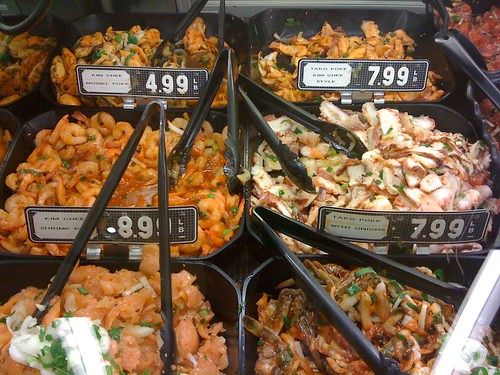
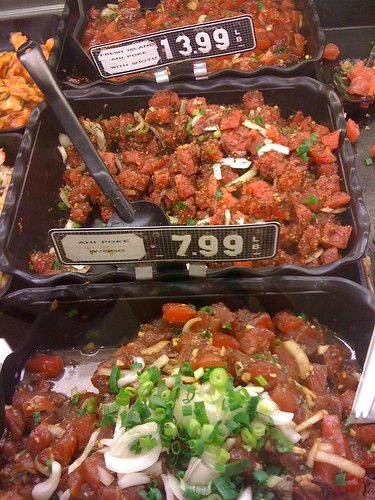
This is what we ate in the car — the traditional Hawaiian version of “fast food” — ahi and mussel poke:
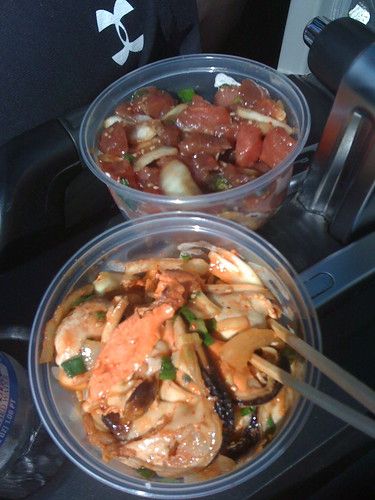
Coconut Candy
Coconut is everywhere in Hawaii, of course. One of my favorite things I had was a little bag of candy I picked up at the local market. It was a coconut candy, made with chips of coconut dried and sweetened with a little sugar. Heavenly! Yeah, it was refined sugar, but there were no other additives. I wonder if I could make this at home with a more natural sweetener in my dehydrator?
Traditional Japanese Breakfast
The first morning in Hawaii, I ordered a traditional Japanese breakfast at our hotel, the Four Seasons Maui. I had this breakfast the last time I was in Hawaii — 15 years ago. (Far too long to be away from Hawaii — must go more often!) I loved it so much the first time I had it, I’ve craved it ever since.
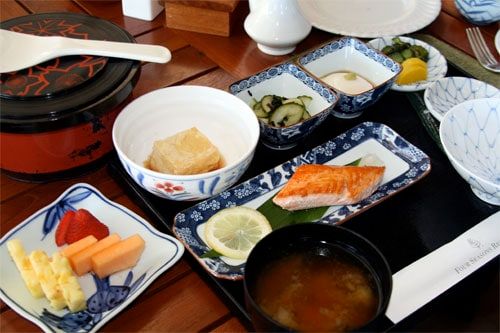
I know it may sound odd to Westerners, eating fish and rice for breakfast, but the Japanese breakfast is delicious and very nourishing. Miso soup, fish (I had salmon), rice, fresh fruit, pickles, and a soft-boiled egg. Plus some green tea. It was the perfect amount of food — just right before a day of lounging in the sun by the pool.
I did drink the miso soup and I didn’t notice any ill effects so maybe it didn’t contain any MSG — or if it, did they didn’t use a lot of it. Not like at Da Kitchen.
Some of Our Favorite Meals
Mama’s Fish House
Out of all the meals we had on Maui, Mama’s Fish House was far and away our favorite. Everything we ate was unbelievably delicious.
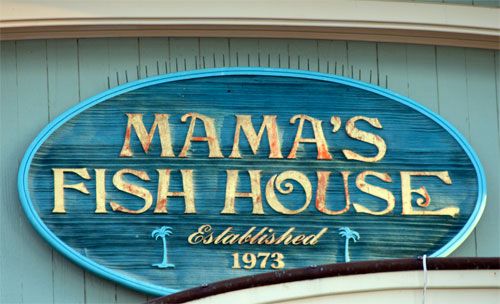
One of the best things about it is all of the fish is local. The waiter said there was one fish that was not local to Maui — flown in from Oahu. This is not true of most restaurants in Hawaii. You have to ask what fish they have that’s local. Normally they’ll say a few are local, but most are flown in from places like Japan.
Here’s the view of the beach, just steps away from the restaurant:
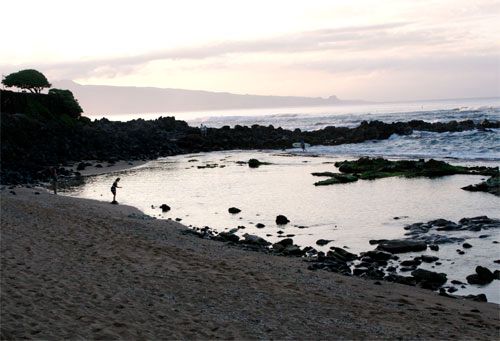
The beach is beautiful there on the North Shore of Maui. This photo does not do it justice. If you go to Mama’s Fish House (and if you go to Maui, you simply must go) get there a little early so you can enjoy the sunset on the beach before you eat. Of course, you’ll also enjoy the beach while you eat, since all the tables have an amazing view.
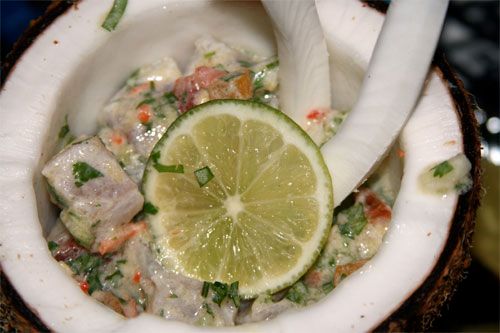
For a starter, I ordered Opakapaka Marinated in Coconut Milk and Lime. This was my favorite thing I ate the entire trip. The fish was raw and marinated — like a ceviche. There was something about the combo of lime and coconut milk that just blew me away. It reminded me of that song, “You take the lime and the coconut and drink it all up.”
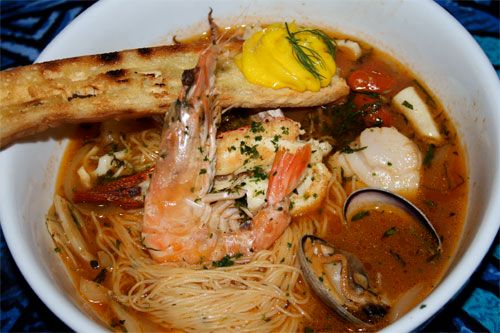
Seth ordered the Bouillabaisse for his entree. I tasted it — so good! Words cannot express.
Hali’imaile General Store
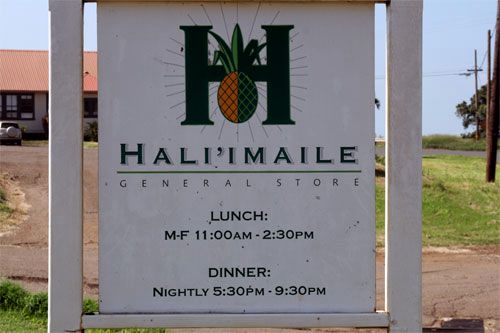
We went to the Hali’imaile General Store, Chef Bev Gannon’s restaurant, for lunch, just before we set out on our drive on the Road to Hana.
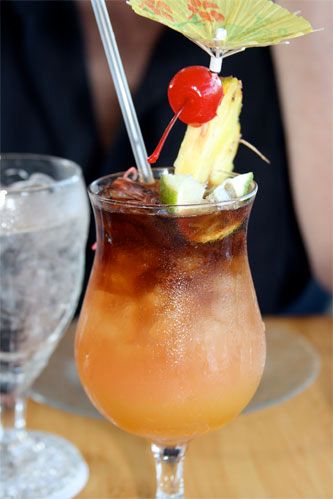
Yes, we had Mai Tais at lunch. Well, Seth did anyway. I had white wine which I enjoyed very much. I actually tasted a pineapple wine (not at the Hali’imaile General Store — I got some at the local market and I drank it in the hotel room), Maui Blanc, from the Tedeschi Vineyards located on Maui. It was delicious!
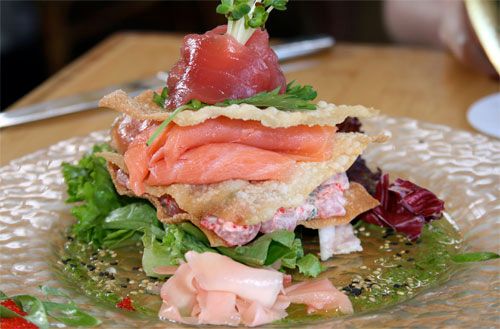
This was our appetizer — the Sashimi Napoleon. Definitely the best thing we had there, although everything we tried was fabulous. Here’s the recipe.
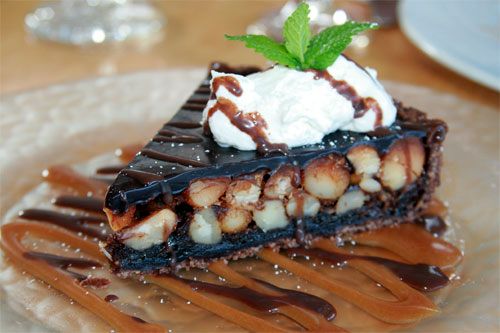
For dessert, we had the Macadamia Nut Pie. It was good. A little rich for my taste, though — so sweet! But I did like all the nuts. Macadamia nuts are so rich in good fats.
But, I must say, I wasn’t very interested in eating dessert very often on Maui. I was just too full from seafood. I have never had such an abundance of fresh, delicious seafood as I did in Maui. I really didn’t want much of anything else.
I hope you enjoyed vicariously eating in Hawaii. I’m going to learn how to make poke at home. I promise to post the recipe.
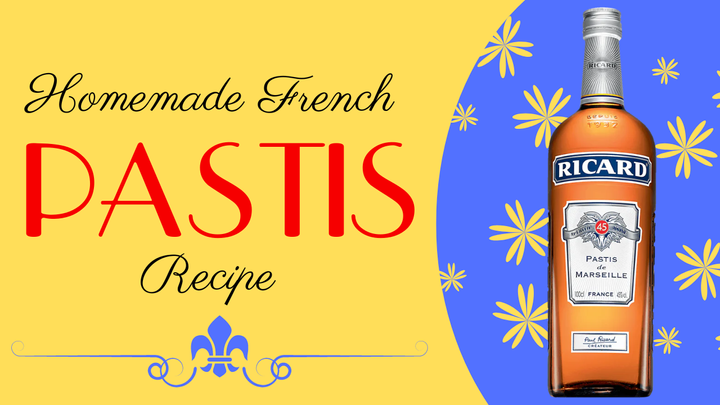


Comments ()